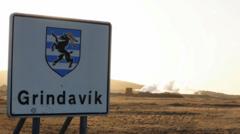The eruption is part of heightened volcanic activity in the area that began with significant earthquake activity early Tuesday morning. Authorities had preemptively evacuated Grindavík and the nearby Blue Lagoon spa, well-known among tourists. Despite evacuation orders, reports suggest some residents have refused to leave their homes. With approximately 4,000 residents, most of whom were previously evacuated in November 2023 due to earlier volcanic threats, the region is on high alert.
By 11:00 local time, the original fissure had expanded and a new crack was detected, prompting officials to urge the remaining residents to evacuate immediately. The police chief noted that only around 40 homes remained occupied, suggesting a significant decrease in population in light of ongoing volcanic threats.
The area surrounding the eruption, where a lengthy magma tunnel spans approximately 11 km (6.8 miles) beneath the surface, is closely monitored. Wind patterns indicate that gas pollution could affect the northeastern areas, including the capital.
The Reykjanes Peninsula has experienced multiple eruptions since 2021, marking a return to volcanic activity after an 800-year hiatus. Iceland is home to 33 active volcanic systems, residing on the Mid-Atlantic Ridge, an area where two major tectonic plates converge.
Authorities continue to assess the situation as they monitor both the eruption and its impact on the local environment and infrastructure, assuring that flights remain operational for now.
By 11:00 local time, the original fissure had expanded and a new crack was detected, prompting officials to urge the remaining residents to evacuate immediately. The police chief noted that only around 40 homes remained occupied, suggesting a significant decrease in population in light of ongoing volcanic threats.
The area surrounding the eruption, where a lengthy magma tunnel spans approximately 11 km (6.8 miles) beneath the surface, is closely monitored. Wind patterns indicate that gas pollution could affect the northeastern areas, including the capital.
The Reykjanes Peninsula has experienced multiple eruptions since 2021, marking a return to volcanic activity after an 800-year hiatus. Iceland is home to 33 active volcanic systems, residing on the Mid-Atlantic Ridge, an area where two major tectonic plates converge.
Authorities continue to assess the situation as they monitor both the eruption and its impact on the local environment and infrastructure, assuring that flights remain operational for now.



















